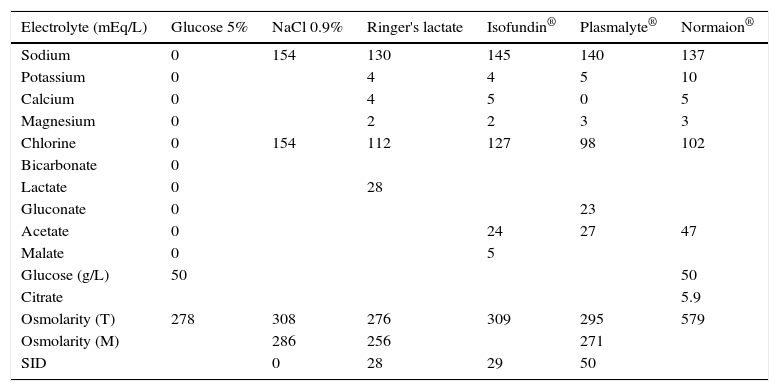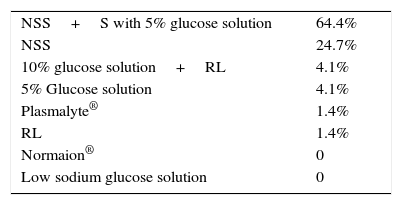To assess the types of maintenance fluids used in our hospital, comparing their volume and composition to the standards recommended by the guidelines.
Material and methodsObservational, cross-sectional study. Volume and type of fluid therapy administered during 24h to patients admitted to various hospital departments were recorded. Patients receiving fluid therapy because of water-electrolyte imbalance were excluded.
ResultsOut of 198 patients registered, 74 (37.4%) were excluded because they did not meet the criteria for inclusion. Mean administered volume was 2500cc/day. Mean daily glucose dose was 36g per 24h (SD: 31.4). The most frequent combination included normal saline solution (NSS) and glucose 5% (64.4%). Mean daily dose of sodium and chlorine was, respectively, 173mEq (SD: 74.8) and 168mEq (SD: 75), representing a surplus daily dose of +87.4mEq and +85mEq. Potassium, magnesium and calcium daily deficit was, respectively, −50mEq, −22mEq and −21mEq per day. Buffer administration was exceptional, bicarbonate (2.29%), acetate (1.29%), lactate (1.15%) and gluconate (1.10%) being the buffering agents most frequently used.
ConclusionNNS is the most frequently used solution. In contrast to excess doses of sodium and chlorine, there is a great deficit of other ions, buffering agents and caloric intake in the fluid therapy regimens that are usually prescribed.
Evaluar el tipo de «fluidos/sueros» de mantenimiento administrados en nuestro hospital, y comparar como se ajustan a las recomendaciones actuales, tanto en volumen como en composición.
Material y métodosEstudio observacional y transversal. Se registró el volumen y tipo de fluidoterapia de mantenimiento que se pautaba durante 24h a pacientes ingresados en diferentes servicios del hospital. Se excluyeron aquellos en los que la administración de líquidos estuviese condicionada por un exceso o déficit de líquidos y electrólitos.
ResultadosSe recogieron los datos de 198 pacientes, de los cuales 74 (37,4%) fueron excluidos por no cumplir los criterios de inclusión. El volumen medio administrado fue de 2.500cc/día. La dosis media de glucosa fue de 36g cada 24h (DE: 31,4). La combinación más frecuente incluyó suero salino fisiológico (SSF) con glucosado 5% (64,4% de los casos). La cantidad media de sodio administrada en 24h fue de 173mEq (DE: 74,8) y la de cloro de 168mEq (DE: 75), lo que supone superávit de +87,4mEq y +85mEq, respectivamente. En relación con el potasio, magnesio y calcio, el déficit fue de −50mEq, −22mEq y −21mEq día, respectivamente. La administración de sustancias buffer fue excepcional, siendo las más frecuentemente utilizadas el bicarbonato (2,29%), acetato (1,29%), lactato (1,15%) y gluconato (1,10%).
ConclusiónEl SSF es la solución más frecuentemente utilizada. En contraste con el exceso de sodio y cloro habitualmente pautado, la cantidad de otros iones, como potasio, magnesio, sustancias buffer y aporte calórico, es muy deficitaria.











